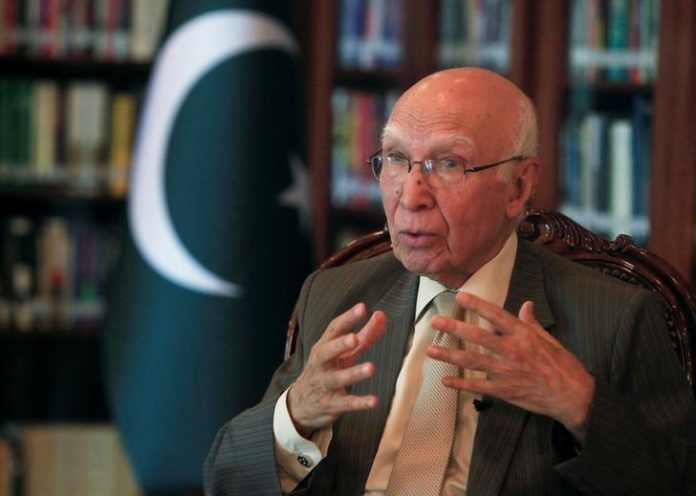ISLAMABAD
Deputy Chairman Sartaj Aziz said that Pakistan has been suffering from a multi-dimensional energy crisis in the past decade. Power shortages coupled with high cost of electricity have had a very negative impact on the economy and on the lives of the people. While new investments were discouraged by the difficult security situation, production from existing capacity was seriously affected by electricity and gas load shedding. As a result, the growth rate had slowed down to an average of 3 per cent between 2006 and 2013.
Sartaj Aziz while addressing the International Conference on Sustainable Energy Technologies said that the most important thrust of this effort was the CPEC energy package to add 17000 MW to the existing installed capacity of about 20000 MW.
Of this, about half is in the Early Harvest portfolio which will become operational before the end of 2018.
Aziz said that the most of the power projects under CPEC are in PPP mode involving an investment of over $ 30 billion by Chinese companies. Pakistan will buy the electricity at up-front announced prices and will not thus add to it debt burden.
He said that in addition to CPEC energy projects, several other projects are being undertaken to add 3000 MW to the system.
While addressing on energy crises, he said that simultaneously, attention is being paid to transmission and distribution. During the year 2016-17 the NTDC transmission has been enhanced by adding 3,000 MVA and 2,400 MVA on 500 kV and 220 kV systems respectively.
The transmission lines were extended by 87 km. To enhance the transmission capacity during 2017-18, about 1,200 MVA of 500 kV and 3,000 MVA of 220 kV will be installed along with 1,853 km of 500 kV and 809 km of 220 kV of transmission lines.
With these projects, the immediate problem of energy shortage will be resolved but the challenge of many other structural issues remains to be addressed especially the energy mix.
Currently, the share of thermal capacity based on imported oil is almost 40 per cent. Even after the recent decline in oil prices, electricity generated from imported furnace oil or diesel is Rs 15-17 per unit. Since the average sale price is Rs 9 per unit; this heavy dependence on imported energy is the main cause of the problem of circular debt. We need a decisive shift to indigenous resources to reduce dependence on imported energy.
He said that as emphasised in Vision 2025, an optimum sustainable energy mix has to be evolved with reference to the indigenous source, economic feasibility and environmental impact. Two important upcoming hydel projects i.e. Dasu and Daimer Bhasha will help to improve the energy mix to a considerable extent. Import of LNG has also helped to alleviate the shortage of gas in the country.
Aziz said that another major challenge is energy efficiency and conservation through a larger investment and improved technologies. Simple and sensible steps to ensure energy efficiency and conservation will save money, reduce energy demand and curb CO2 emissions. For this purpose, the government is encouraging the use of energy efficient air conditioners, energy efficient lights (LEDs), and solar water heaters while seeking improvement in transmission and distribution system to reduce line losses and theft.
He also added that the contribution of renewable energy from solar and wind is at present less than 1 per cent. But with the drastic reduction in prices, prospects for solar energy are improving. Solar power is already competitive vis-à-vis diesel-based captive power generation. Irrigation pumps are being converted to solar in private and public sectors. Rooftop electricity generation, both in residential, industrial and commercial sectors will become more significant after 2020. Small off grid solar units are also spreading rapidly in rural areas through the private sector.
He said that in each of the areas, improved technologies can play an important role in reducing costs and increasing the efficiency of the system. I hope this conference will make an important contribution to achieving these objectives.




